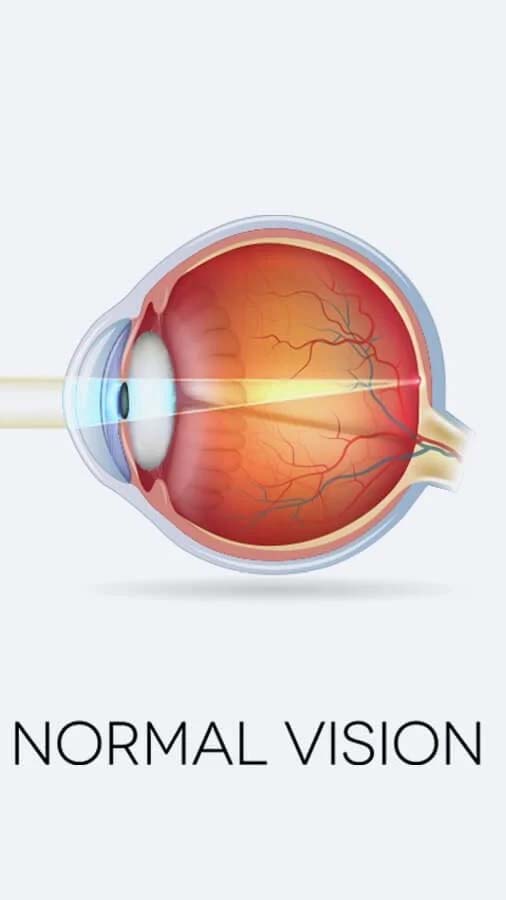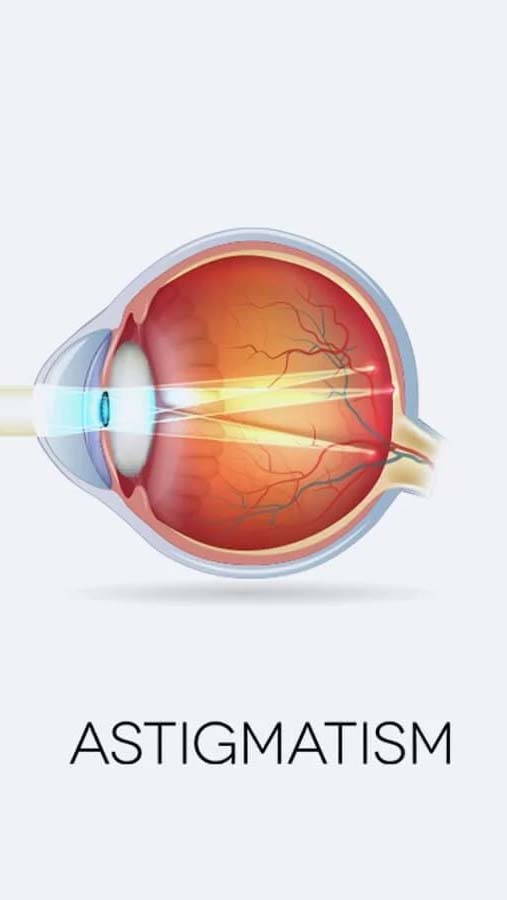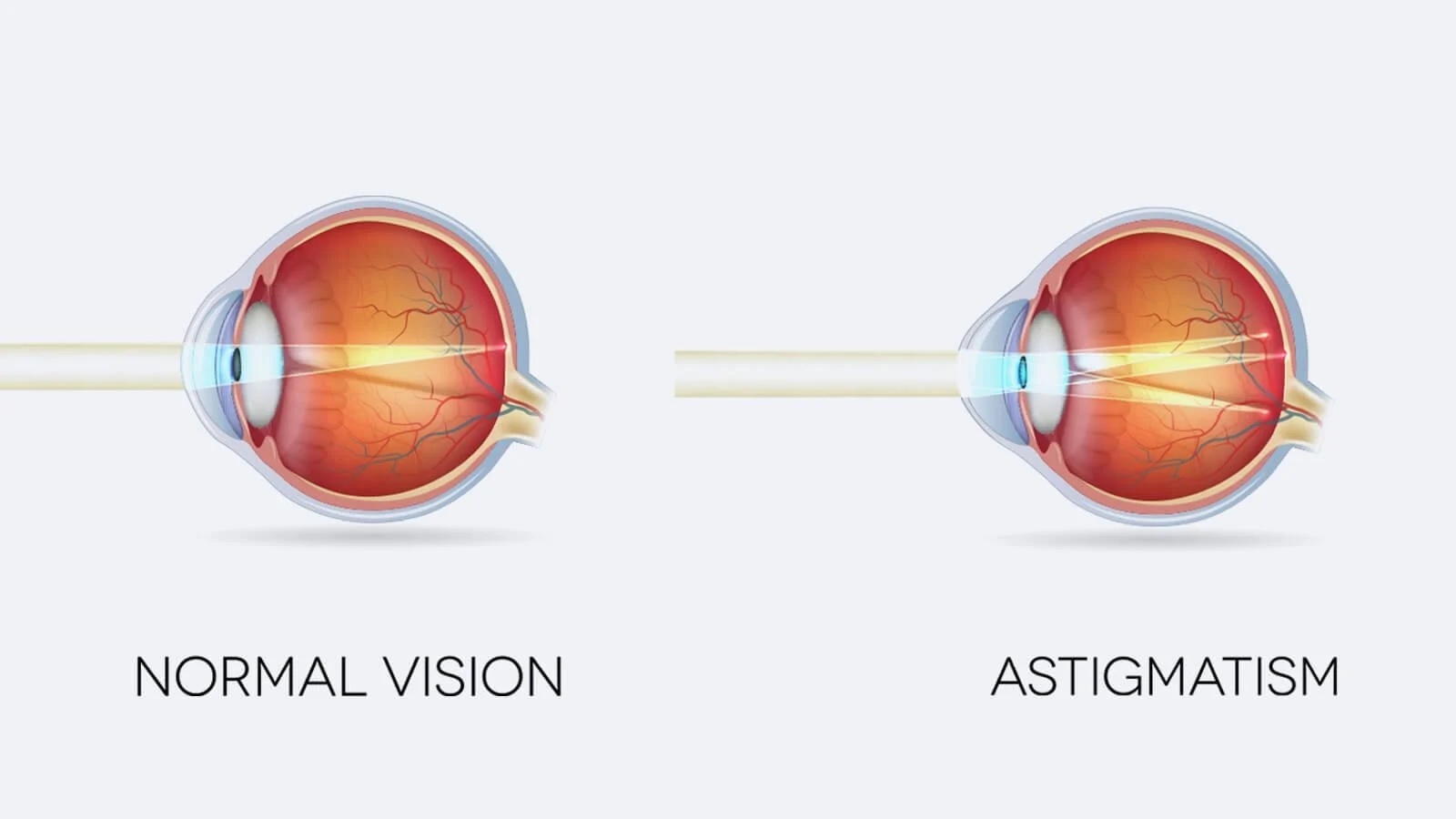Astigmatism
Astigmatism
All you need to know about
Astigmatism
Astigmatism (uh-STIG-muh-tiz-um) is a defect in the curve of the eye that produces blurring distance and close vision.
When the front surface of the eye (cornea) or the lens inside the eye has uneven curves, astigmatism arises. The surface is egg-shaped, rather than having a single curve like a spherical ball. At all distances, this causes hazy vision.
Astigmatism is frequently present at birth and can coexist with nearsightedness or farsightedness. Often, it isn’t severe enough to necessitate corrective action. Corrective lenses or surgery are two choices for treatment if this is the case.
Symptoms of Astigmatism
Astigmatism symptoms vary from person to person. Some folks show no signs or symptoms at all. The following are the primary signs and symptoms of astigmatism:
- A vision that is unclear, distorted, or fuzzy at all distances (up close and far away)
- Having trouble seeing at night
- Eyestrain
- Squinting
- Inflammation of the eyes
- Headaches
If you have signs of astigmatism, you should see a doctor or optometrist. Other health or eyesight issues could potentially be causing some of the symptoms.
What causes Astigmatism?
Two structures with curved surfaces in the eye bend (refract) light onto the retina, producing images:
- The cornea, which is the transparent front surface of the eye, as well as the tear film, are all important parts of the eye.
- The lens is a transparent structure inside the eye that changes shape to aid in focusing on close objects.
Each of these parts in a properly shaped eye has a round curvature, similar to the surface of a smooth ball. A cornea or lens with this curvature bends (refracts) all incoming light in the same way, resulting in a finely focused image on the retina at the rear of the eye.
A refractive error
Light rays are not bent in the same way if either the cornea or the lens is egg-shaped with two misaligned curves, resulting in two separate pictures. The hazy eyesight is caused by the overlap or combination of these two images. Refractive error astigmatism is a form of refractive error.
When the cornea or lens is curved more sharply in one direction than the other, astigmatism results. If the curves of your cornea are misaligned, you have corneal astigmatism. If your lens has uneven curves, you have lenticular astigmatism.
Blurred vision can be caused by either form of astigmatism. Blurred vision can occur in a variety of directions, including horizontally, vertically, and diagonally.
Other refractive errors
Short-sightedness (Myopia) is a condition that occurs when a person. When the cornea is bent too much or the eye is longer than normal, this happens. Light is concentrated in front of the retina instead of directly on the retina, making distant things appear hazy.
Long-sightedness (hyperopia). This happens when the cornea isn’t curved enough or the eye isn’t as long as it should be. The result is diametrically opposed to nearsightedness. The light never comes to a focus at the rear of the eye while the eye is relaxed, making adjacent objects appear hazy.
Who’s at risk for astigmatism?
Both children and adults can develop astigmatism. If you have any of the following, your chances of acquiring astigmatism are increased:
- A history of astigmatism or other eye problems like keratoconus in the family (degeneration of the cornea)
- Corneal scarring or thinning is a condition in which your cornea is scarred or thinned.
- Short-sightedness is a condition that causes fuzzy vision at a distance.
- Excessive long-sightedness, resulting in hazy close-up vision
- A history of surgery on the eyes, such as cataract surgery (surgical removal of a clouded lens)
Types of astigmatism
Corneal and lenticular astigmatism are the two most common kinds of astigmatism. When there is a defect or distortion in the cornea, it causes corneal astigmatism. When the lens is distorted, it causes lenticular astigmatism.
Astigmatisms are also referred to as regular or irregular astigmatisms. When the eye isn’t totally curved, it’s called astigmatism. As a result, instead of being round like a basketball, it may be shaped like a football. This frequently results in hazy, distorted eyesight.
When the eye isn’t fully round, it can develop irregular astigmatism, which is less common. Irregular astigmatism, on the other hand, differs from regular astigmatism in that the curvature of the eye is uneven. Vision distortion and blurriness are also symptoms of this impairment.



Treatments
Mild astigmatism may not necessitate treatment. One of the following treatments may be used by your doctor to address astigmatism that causes visual issues.
Corrective lenses
Glasses
The lenses in glasses are designed to compensate for the irregular shape of the eye. The lenses bend the light properly into the eye. Other refractive defects, like short-sightedness or long-sightedness, can be corrected using glasses.
Lenses
Contact lenses, like glasses, can correct most astigmatism. They come in a wide range of types and styles.
Orthokeratology is a procedure that involves the use of contact lenses. Orthokeratology is a technique in which stiff contact lenses are worn at night while sleeping to even out the curvature of the eye. To keep the new shape, the lenses are worn less frequently. If treatment is stopped, the eye’s shape and refractive error return to normal.
The risk of infection in the eye increases when contact lenses are worn for long periods of time.
Enquire with your eye doctor about the benefits, drawbacks, and hazards of wearing contact lenses, as well as which option is ideal for you.
Orthokeratology (Ortho-K)
Orthokeratology (Ortho-K) is a procedure that uses hard contact lenses to straighten the abnormal curvature of your cornea for a short period of time. You’ll only be using hard contact lenses for a short while. You can wear them at night and then take them off throughout the day.
When Ortho-K is used, some people report having clear vision during the day without the use of corrective lenses. The advantages of Ortho-K are only apparent when it is used. After you stop using Ortho-K, your vision will return to normal.
Refractive surgery
Refractive surgery enhances vision and reduces the need for contact lenses or glasses. An eye surgeon reshapes the curvature of the cornea with a laser beam to correct refractive error. Doctors will evaluate you before surgery to see if you are a good candidate for refractive surgery.
Astigmatism can be treated with a variety of refractive surgeries, including:
- In-situ keratomileusis with laser assistance (LASIK). An eye surgeon creates a thin, hinged flap in the cornea with this surgery. He or she sculpts the shape of the cornea using an excimer laser before repositioning the flap.
- Subepithelial keratectomy with laser assistance (LASEK). Instead of making a flap in the cornea, the surgeon uses specific alcohol to loosen the cornea’s thin protective layer (epithelium). He or she changes the curvature of the cornea with an excimer laser before repositioning the loosened epithelium.
- Keratectomy with photorefractive keratectomy (PRK). The epithelium is removed in this treatment, which is identical to LASEK. It will regrow normally, according to the altered shape of the cornea. After surgery, you may need to wear a bandage contact lens for a few days.
- Epi-LASIK. This is a LASEK variant. Instead of using alcohol, the surgeon separates a very thin sheet of epithelium with a specific motorised blunt blade. He or she next reshapes the cornea and repositions the epithelium with an excimer laser.
- Lenticule extraction with a little incision (SMILE). This newer type of refractive surgery reshapes the cornea by creating a lens-shaped lenticule beneath the cornea’s surface with a laser. After that, the lenticule is removed by a very little incision. The SMILE operation is currently only approved for the treatment of mild short-sightedness.
Clear lens extraction and implanted contact lenses are two other forms of refractive procedures. There is no one-size-fits-all approach to refractive surgery, and you should only make a decision after a comprehensive examination and conversation with your physician.
Following refractive surgery, the following are some of the possible complications:
- Your initial problem has been undercorrected or overcorrected.
- Visual effects such as a halo or starburst around lights are common.
- Dry eye
- Scarring of the cornea
- Vision loss is a rare occurrence.
Consult your eye doctor about the risks and benefits of these procedures.


